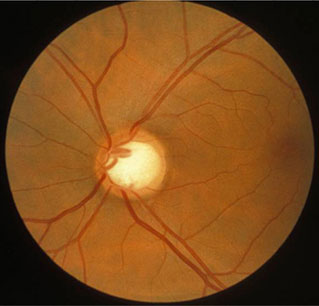Summary
Definition
History and exam
Key diagnostic factors
- cup-to-disk ratio >0.5
- notching of optic nerve cup
- symptomatic peripheral vision loss
- increased intraocular pressure
- scotomas
- loss of nerve fiber layer
- optic disk hemorrhage
Other diagnostic factors
- corneal hysteresis
Risk factors
- intraocular pressure >21 mmHg
- age >50 years
- family history of glaucoma
- genetic abnormalities
- black ethnicity or Hispanic ethnicity
- myopia
- diabetes mellitus
- hypertension
- low ocular perfusion pressure
- thin central corneal thickness
- corneal hysteresis
- calcium-channel blockers
Diagnostic tests
1st tests to order
- tonometry
- gonioscopy
- direct ophthalmoscopy
- indirect ophthalmoscopy
- slit-lamp biomicroscopy
- visual field testing
- optical coherence tomography scanning
Tests to consider
- digital imaging
- pachymetry
- nerve fiber layer analysis
Emerging tests
- corneal hysteresis
Treatment algorithm
eye drops preferred or laser trabeculoplasty contraindicated/failed
laser trabeculoplasty preferred or eye drops contraindicated /failed
eye drops contraindicated /failed and rapidly progressive disease
treatment failure
Contributors
Authors
Nishani Amerasinghe, MBBS, BSc(Hons), FRCOphth
Consultant Ophthalmic Surgeon
Glaucoma Specialist
University Hospital Southampton NHS Trust
Southampton
UK
Disclosures
NA is president-elect of the UK and Éire Glaucoma Society and has acted as an unpaid advisor to NICE and The Royal College of Ophthalmologists. NA has served on an advisory panel for Santen and has received travel honoraria and speaker's fees from Thea Pharmaceuticals, Santen, and Allergan. NA has received research funding from AbbVie Pharmaceuticals.
Irena Serov-Volach, MD
Senior Glaucoma and Cataract Fellow
Ophthalmology department
Eye Unit
Epsom and St Helier University Hospitals NHS Trust
London
UK
Disclosures
ISV has received consultancy/travel fees from Glaukos.
Acknowledgements
Dr Nishani Amerasinghe and Dr Irena Serov-Volach would like to gratefully acknowledge Dr Robert B. Avery and Dr Michael N. Wiggins, the previous contributors to this topic.
Disclosures
RBA and MNW declare that they have no competing interests.
Peer reviewers
Andrew Chen, MD
Assistant Professor
University of Washington
Seattle
WA
Disclosures
AC declares that he has received research funding from Janssen LLC.
Sheila Sanders, MD
Professor of Ophthalmology
University of Kentucky
South Limestone
Lexington
KY
Disclosures
SS declares that she has no competing interests.
Mohamed Khodeiry, MD
Glaucoma Fellow
University of Kentucky
South Limestone
Lexington
KY
Disclosures
MK declares that he has no competing interests.
Roshini Sanders, FRCS, FRCOphth
Consultant Ophthalmologist
Queen Margaret Hospital
Dunfermline
Fife
UK
Disclosures
RS declares that she has no competing interests.
Peer reviewer acknowledgements
BMJ Best Practice topics are updated on a rolling basis in line with developments in evidence and guidance. The peer reviewers listed here have reviewed the content at least once during the history of the topic.
Disclosures
Peer reviewer affiliations and disclosures pertain to the time of the review.
References
Key articles
Weinreb RN, Leung CK, Crowston JG, et al. Primary open-angle glaucoma. Nat Rev Dis Primers. 2016 Sep 22;2:16067. Abstract
International Council of Ophthalmology. ICO guidelines for glaucoma eye care. Feb 2016 [internet publication].Full text
American Academy of Ophthalmology. Primary open-angle glaucoma preferred practice pattern. Nov 2020 [internet publication].Full text
American Academy of Ophthalmology. Primary open-angle glaucoma suspect preferred practice pattern. Nov 2020 [internet publication].Full text
National Institute for Health and Care Excellence. Glaucoma: diagnosis and management. Jan 2022 [internet publication].Full text
Reference articles
A full list of sources referenced in this topic is available to users with access to all of BMJ Best Practice.

Differentials
- Normal-tension glaucoma
- Angle-closure glaucoma
- High myopia
More DifferentialsGuidelines
- Glaucoma summary benchmarks - 2024
- Trabeculectomy with a biodegradable collagen matrix implant for glaucoma
More GuidelinesPatient information
Glaucoma
More Patient informationLog in or subscribe to access all of BMJ Best Practice
Use of this content is subject to our disclaimer